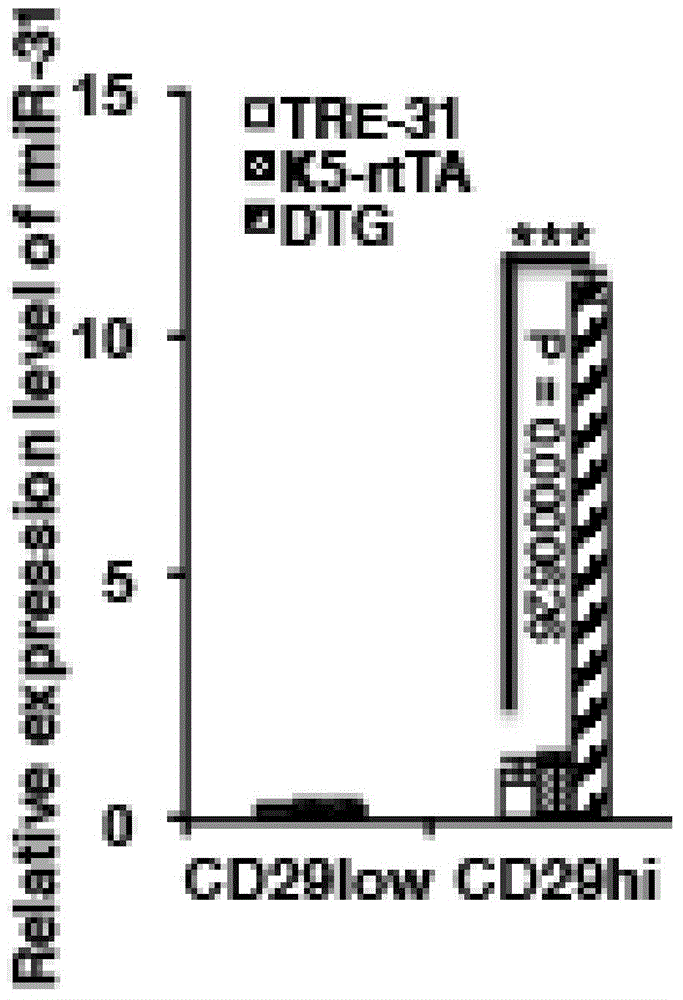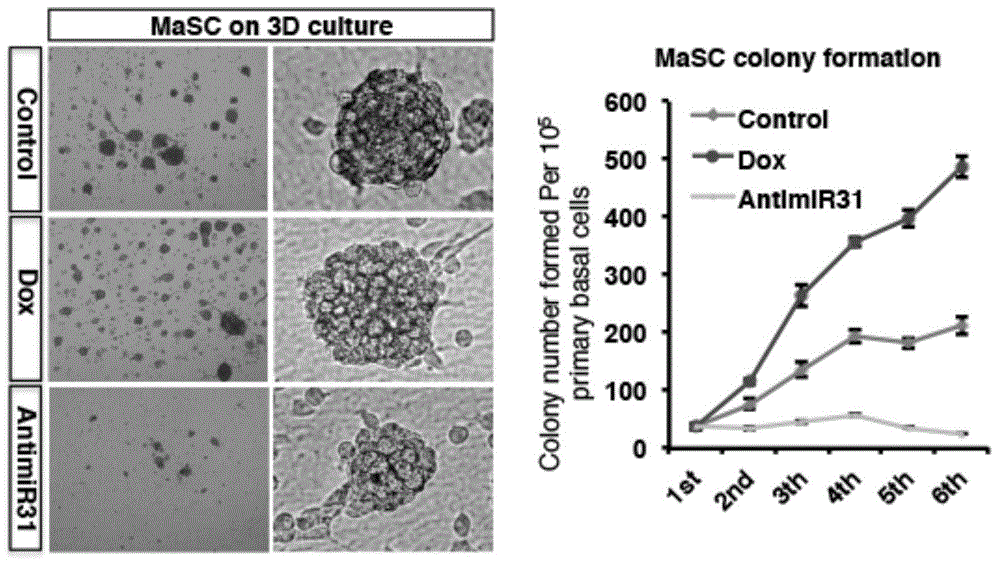Method for inducing self-renewal of mammary stem cells
A technology of mammary gland stem cells and mammary glands, which is applied in the field of small molecule RNA, can solve problems such as ignorance of the role, and achieve the effect of enhancing the ability of cloning formation
- Summary
- Abstract
- Description
- Claims
- Application Information
AI Technical Summary
Problems solved by technology
Method used
Image
Examples
Embodiment 1
[0025] Example 1 Isolation of mammary gland stem cells
[0026] 1. Take the fresh mammary gland tissue of the mouse, remove the lymph nodes, put it into a 10cm cell culture dish, put it on ice, and cut the mammary gland tissue as much as possible with a scalpel and tweezers.
[0027] 2. Put the breast tissue above into a 15mL centrifuge tube, add an appropriate amount of collagenase / hyaluronidase digestion solution to it, place it in a hybridization oven at 37°C and rotate it, and digest for 6-8 hours.
[0028] 3. After the mammary gland tissue is completely digested, centrifuge at 350xg for 5-10 minutes, and carefully discard the supernatant.
[0029] 4. Add 2-3mL ammonium chloride solution to the above breast tissue fragments to destroy red blood cells in the breast tissue. Centrifuge at 350xg for 5 minutes and discard the supernatant.
[0030] 5. Add 1-2mL trypsin and mix up and down with a pipette for 1-3min. Immediately add 10 mL of pre-cooled HBSS buffer solution to s...
Embodiment 2
[0035] Example 2Dox induces miR-31 expression and detection of miR-31 in K5rt-TA / TRE-miR-31 transgenic mouse mammary gland tissue
[0036] 1. Use water containing 2 g / L Dox to feed 3-week-old K5rt-TA / TRE-miR-31 double positive mice, while feeding K5rt-TA or TRE-miR-31 single positive mice as a control. Mice were sacrificed at 12 weeks for sampling.
[0037] 2. After the mice were killed by dislocation, the lymph nodes were removed with RNase-removing surgical scissors and surgical forceps, and the mammary gland tissue was placed in a DEPC-treated 1.5mL centrifuge tube, and 1mL Lysis Binding Buffer was added to it. Homogenize with a homogenizer for 10-15 minutes until the tissue is completely lysed, then add 100 μL HomegenateAdditive to the above homogenate, shake gently several times, and place on ice for 10 minutes.
[0038] 3. Add 1mL of phenolic extract to the above mixture, shake gently for 1min, and centrifuge at 10,000g for 5min until the layers are separated.
[0039] 4...
Embodiment 3
[0047] Example 3 Effect of miR-31 on Mammary Stem Cells In Vitro Clonogenic Ability
[0048] 1. Lin obtained by sorting the method in Example 1 - CD24 + CD29 high The cell population was equally divided into 3 parts, each containing 10 5 cell.
[0049] 2. Using the method of electroporation, 2 cells were electrotransfected with 4 μg of Scramble RNA, and the other cell was electroporated with 4 μg of miR-31 inhibitor (5’-CAGCUAUGCCAGCAUCUUGCCU-3’; Shanghai GenePharma Co., Ltd).
[0050] 3. These cells were resuspended in EpiCult-B culture medium, and cultured on cell culture scaffolds (Millipore Cor., Billerica, USA). The culture medium is EpiCult-B culture medium adding growth-promoting factors, including 10ng / mL recombinant human Epidermal Growth Factor (rhEGF; Catalog #02633, Stem Cell Technologies), 10 ng / mL recombinant human Basic Fibroblast Growth Factor (rh-bFGF; Catalog # 02634, Stem Cell Technologies), 4 μg / mL (0.0004%) Heparin (Catalog #07980, Stem Cell Technolog...
PUM
 Login to View More
Login to View More Abstract
Description
Claims
Application Information
 Login to View More
Login to View More - R&D
- Intellectual Property
- Life Sciences
- Materials
- Tech Scout
- Unparalleled Data Quality
- Higher Quality Content
- 60% Fewer Hallucinations
Browse by: Latest US Patents, China's latest patents, Technical Efficacy Thesaurus, Application Domain, Technology Topic, Popular Technical Reports.
© 2025 PatSnap. All rights reserved.Legal|Privacy policy|Modern Slavery Act Transparency Statement|Sitemap|About US| Contact US: help@patsnap.com



